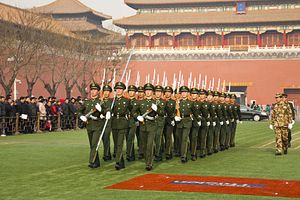On November 26, Chinese President Xi Jinping – who also serves as chair of the Central Military Commission – announced a sweeping long-term reform plan for the People’s Liberation Army. The reforms, laid out at a meeting attended by over 200 military officials, will see streamlined command over China’s military, as well as a closer watch on corruption and graft.
China currently has seven separate military commands, headquartered in Shenyang, Beijing, Jinan, Nanjing, Guangzhou, Chengdu, and Lanzhou. That structure, and the relative independence enjoyed by each regional commander, makes joint operations (particularly overseas) difficult to organize and execute. Under the reform plan, China would reorganize the commands. Xi did not go into detail on the reform plan, but South China Morning Posts expects the restricted military to have only four military commands.
China will also move to create new “battle zone commands” designed to streamline joint operations. And the entire military structure would be overseen by a joint command, further emphasizing the necessity of interoperability between China’s military branches.
Defense Ministry spokesperson Yang Yujun told reporters that the reforms “will focus on removing systematic barriers that had constrained military development in order to boost modernization of the military as well as cultivate the fighting capacity of troops.”
In addition, the CMC (which Xi currently heads) will take on an even more prominent role in China’s military affairs. The CMC will have “central and unified leadership,” Xi said, and will directly administer and command all military departments (including the PLA as well as the Chinese People’s Armed Police and China’s militia and reserve forces). That effectively tightens Party control over the armed forces, while also strengthening Xi’s already-prominent personal role in governing the military. In his remarks, Xi said the reforms were designed to strengthen the principle that the “Communist Party of China has absolute leadership of the armed forces.”
As part of its exercise of leadership, the CMC will set up a new discipline inspection committee, which will send inspectors to the various departments and zone commands, Xi said. The anti-corruption campaign has moved more slowly through China’s military than through its civilian bureaucracy, as the PLA has its own body responsible for discipline violations. The new CMC discipline inspection committee will give Xi direct authority over the anti-corruption efforts in the military, as well as the ability to appoint hand-picked leaders who are serious about the task of weeding out corruption (see, for example, the immense impact the selection of Wang Qishan to head the Central Commission for Discipline Inspection has had on the anti-corruption drive).
Xi also spoke of creating a new separation in “decision making, enforcement and supervision powers” in order to create a system of “checks and balances” in the military. At this time, it’s still unclear exactly what that system would look like; the Party in general has been strongly resistant to the idea of any checks on power.
Finally, as previously announced, China will also cut its military forces by 300,000 troops, mostly focusing on administrative personnel. Xi also ordered the military to “resolutely terminate all paid services,” which will both trim the fat from PLA payrolls while also discouraging the corruption that often accompanies military-run business deals.
This announcement has been a long time coming – military analysts inside and outside of China have long recommended a streamlined command system that allows for joint command and control. But the plan itself is just the first step in what will be a long and slow process. In making the announcement, Xi said the “breakthrough” should come by 2020, giving Beijing plenty of time to lay the groundwork. The reforms will doubtless face resistance from those who have a vested interest in the current system, but Xi is determined to carry through the restructuring – which will have important implications for China’s national security.
“As the country progresses from a large country to a large and powerful one, defense and military development stands at a new and historic starting line,” Xi said. In order to truly modernize its military, China will need not just new technology, but a reorganized command structure that reflects how much China’s national security interests – not to mention warfare itself – have changed since the last round of major reforms in the 1980s. By 2020, Xi wants a military that is more nimble and flexible, able to respond to diverse threats around the world in a way the current military structure can’t accommodate.
However, Defense Ministry spokesperson Yang reassured reporters that the military reforms will not alter China’s basic defense policy, which is “defensive in nature.”

































